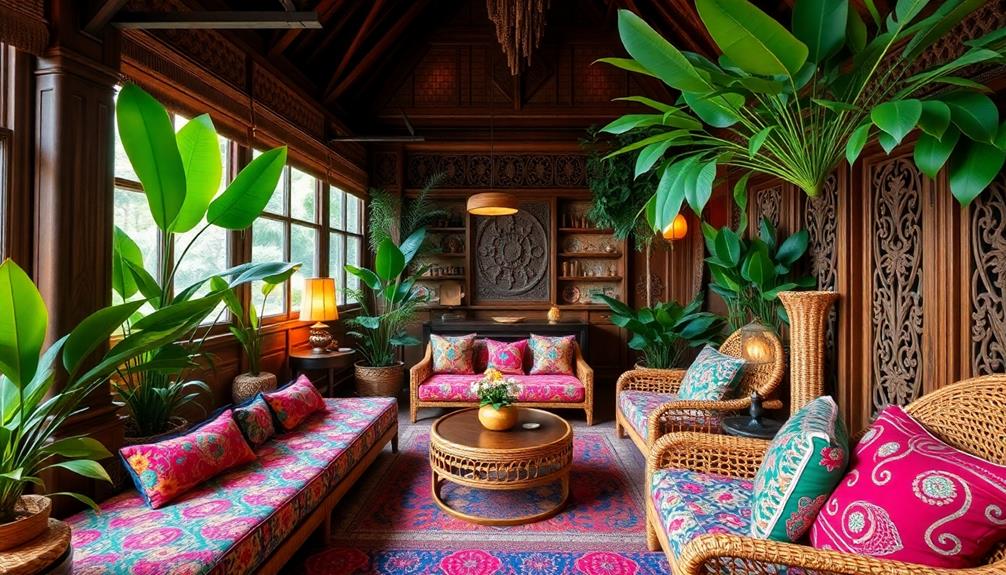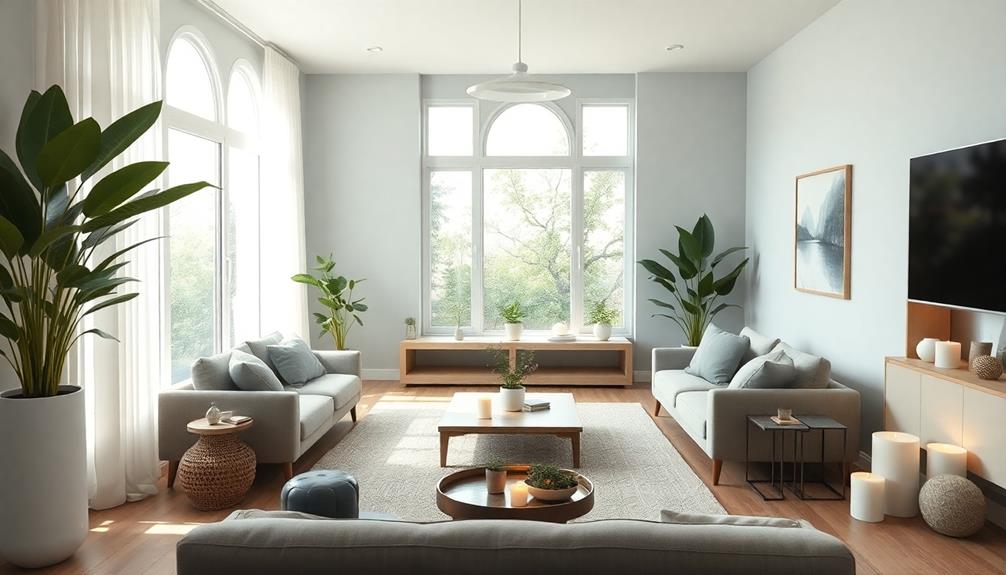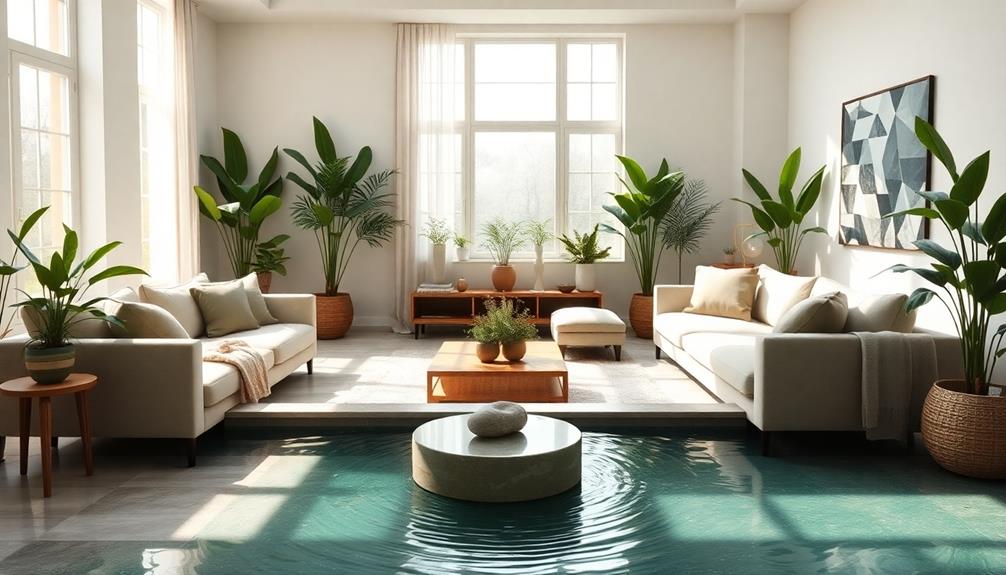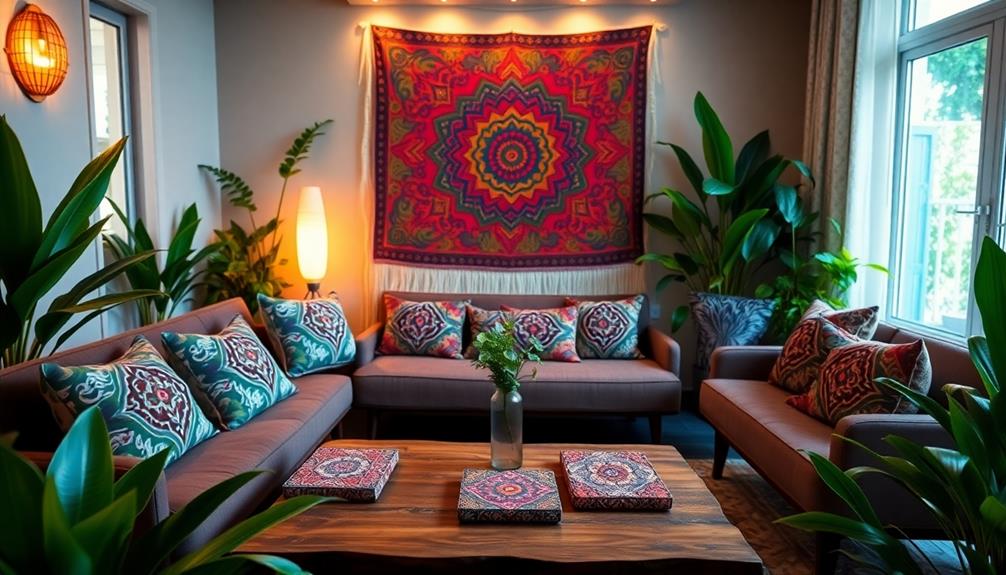To instantly elevate your space, incorporate Indonesian textiles like ikat and batik. These vibrant fabrics bring rich colors and intricate patterns that reflect a beautiful cultural heritage. Use ikat pillows or batik wall hangings to add depth and create striking conversation starters. Not only do these textiles support local artisans, but they also invite personal stories and emotional connections into your decor. Layer different patterns and choose complementary colors to unify your aesthetic. With each piece, you're enhancing your home's character while celebrating craftsmanship. There's so much more to discover about these textiles and their impact on your space.
Key Takeaways
- Incorporate vibrant batik wall hangings to create focal points that invite conversation and showcase cultural artistry in your space.
- Use ikat throw pillows on seating areas to add texture and color, enhancing comfort while reflecting traditional craftsmanship.
- Layer different textile patterns to create visual interest, combining vibrant colors with earthy tones for a harmonious aesthetic.
- Select batik table runners for dining spaces, adding an artistic touch that serves as a conversation starter during meals.
- Display a gallery wall featuring diverse Indonesian textiles, enriching narratives and showcasing the unique stories each piece holds.
The Allure of Indonesian Textiles

When you explore the world of home decor, Indonesian textiles stand out with their vibrant colors and intricate patterns that tell a story of rich cultural heritage.
The allure of these textiles lies in their craftsmanship, particularly in batik, a UNESCO-recognized art form known for its wax-resist dyeing technique. Each piece showcases unique designs often inspired by nature and mythology, bringing a touch of Indonesia into your home.
Many of these textiles, much like the traditional artistry of Indonesian decor masks, reflect the local culture and traditions.
Using natural dyes derived from plants and minerals, these textiles maintain their vivid hues over time without harmful chemicals.
Incorporating batik and other Indonesian textiles into your space not only enhances its visual appeal but also supports local artisans who use traditional techniques passed down through generations.
Cultural Significance of Ikat

Ikat textiles are more than just beautiful fabrics; they connect you to Indonesia's rich cultural heritage.
These textiles often feature intricate designs and vibrant colors, much like the stunning Indonesian decor masks that represent cultural craftsmanship.
Each piece holds deep symbolism, often used in significant ceremonies that mark important life events.
As you explore these stunning textiles, you'll find they evoke emotional ties and memories that resonate personally and culturally.
Cultural Heritage Connection
Rooted in Indonesia's rich cultural heritage, ikat textiles are much more than beautiful fabrics; they embody stories, traditions, and values that have been passed down through generations.
These traditional textiles play a vital role in expressing cultural identity, particularly within Balinese culture. The intricate craftsmanship involved in ikat weaving showcases the artistic heritage of Indonesian artisans, who meticulously tie and dye both warp and weft yarns, resulting in vibrant colors and complex patterns that convey deep cultural narratives.
Incorporating these vibrant textiles into your space can enhance the overall ambiance, much like how Indonesian decorative pillows enrich living environments with comfort and style.
One notable example is the double ikat known as Gerinsing, produced in Tenganan Village, which symbolizes protection and is essential during significant life ceremonies.
By incorporating ikat into your space, you support local heritage and the continuation of these cherished practices. Many artisans also embrace eco-friendly practices, ensuring that their work respects the environment while preserving these age-old techniques.
As you display ikat textiles, you're not just decorating your home; you're fostering emotional connections and keeping the vibrant stories of Indonesian culture alive.
These living art pieces enrich your surroundings, making them more meaningful and culturally resonant.
Symbolism in Ceremonies
Ceremonies in Balinese culture are rich with symbolism, and the presence of ikat textiles amplifies this significance. These textiles, especially the double ikat known as Gerinsing from Tenganan Village, play a crucial role in important life changes, serving as ceremonial dress that embodies protection and community ties.
The intricate patterns and vibrant colors of ikat textiles not only beautify but also tell cultural stories, reflecting the weaver's family history. The weaving process itself is a closely guarded tradition, showcasing the respect for cultural heritage and the commitment to preserving these practices.
| Ceremony Type | Symbolism of Ikat Textiles |
|---|---|
| Weddings | Represents the union and protection |
| Funerals | Honors the deceased and family ties |
| Birth Rituals | Welcomes new life and community support |
| Religious Events | Connects individuals to spiritual beliefs |
| Festivals | Celebrates cultural identity and tradition |
Emotional Ties and Memories
Many people find that ikat textiles evoke strong emotional ties and cherished memories connected to their cultural heritage. Each piece tells a story, reflecting the unique cultural narratives of Indonesia. The vibrant colors and intricate patterns often remind you of personal experiences—perhaps a visit to a village where artisans craft beautiful double ikat Gerinsing, known for its symbolism of protection during significant life ceremonies.
These textiles not only embody artistic expression but also represent the rich cultural heritage and traditions of Indonesia, much like the importance of Indonesian decor masks.
When you incorporate ikat textiles into your space, you're not just adding decor; you're fostering appreciation for traditional craftsmanship. This act supports artisan communities, helping to preserve their rich cultural significance. Each time you admire these textiles, you create lasting connections to the stories and traditions they represent.
These textiles become living art pieces, sparking conversations and evoking emotions tied to family traditions and community practices. As you surround yourself with ikat, you celebrate not only the beauty of vibrant colors but also the deep-rooted heritage they encapsulate.
Ultimately, ikat textiles can transform your environment into a space filled with meaning, reminding you of the invaluable ties that connect us all to our past and to each other.
Weaving Techniques and Craftsmanship

When you explore Indonesian textiles, you'll discover the intricate traditional weaving methods that define their beauty.
Each artisan employs unique craftsmanship techniques, showcasing their skill and dedication to preserving cultural heritage.
Many of these textiles are often used in traditional Indonesian housing, reflecting the cultural significance of housing and the communities that keep these traditions alive.
Understanding these processes not only highlights the artistry involved but also connects you to the communities that keep these traditions alive.
Traditional Weaving Methods
Embracing the artistry of traditional Indonesian weaving methods reveals a world of intricate craftsmanship and cultural significance. Techniques like ikat and batik involve complex processes where artisans meticulously tie and dye yarns before weaving, showcasing their skill and precision.
The double ikat technique, particularly found in Gerinsing fabrics from Tenganan Village, is rare and symbolizes cultural identity and protection within Balinese society. These textiles not only serve as decorative elements but also embody a deep connection to the traditional Indonesian style home decor, emphasizing harmony with nature and local culture.
One of the most enchanting aspects of these textiles is the use of natural dyes sourced from plants, roots, and minerals. This results in vibrant colors that reflect the landscape and cultural narratives, with beautiful shades like rich reds and deep blues. Each piece serves as a unique representation of cultural heritage, emphasizing the labor-intensive tie-dyeing method that highlights both artistry and the weaver's expertise.
Moreover, many traditional weaving practices are passed down through generations, reinforcing community engagement and the crucial role of women in preserving these techniques. Initiatives like Threads of Life exemplify this commitment, ensuring that these valuable skills and stories endure.
Artisan Craftsmanship Techniques
Delving into artisan craftsmanship techniques reveals the intricate processes behind Indonesian textiles, particularly the ikat weaving method. This meticulous technique involves tying and dyeing both warp and weft yarns before weaving, resulting in stunning patterns and vibrant colors that reflect the weaver's skill.
The use of natural materials and colors harmonizes beautifully with Balinese interior design concepts, promoting a connection to nature through design choices. One striking example is Gerinsing, a double ikat from Tenganan Village, showcasing the rarity and complexity of this craft through closely guarded traditional techniques passed down through generations.
The vibrant hues in ikat fabrics come from natural dyes derived from local plants and minerals, echoing the cultural narratives of the weavers' environment. This craftsmanship not only embodies artistic expression but also fosters emotional connections, as each textile often tells personal stories tied to family traditions and significant life events.
Balinese motifs and patterns can further enhance the beauty of these textiles in your décor.
Artisan communities play an essential role in preserving these traditional techniques and cultural heritage. Organizations like Threads of Life support sustainable practices and fair trade, ensuring artisans benefit from their craftsmanship.
Incorporating Ikat in Decor

Ikat textiles can transform your decor with their vibrant colors and intricate patterns, instantly adding a touch of Indonesian cultural heritage to your space. These textiles reflect the diverse architectural styles of Indonesia and can be beautifully paired with traditional and modern housing elements.
You can incorporate ikat in various ways, from upholstered furniture and throw pillows to table runners and wall hangings. These versatile applications complement both traditional and contemporary design styles, enhancing the visual interest of your home.
Each ikat piece isn't just a decorative item; it's a work of art with a rich story and cultural significance, thanks to the labor-intensive tie-dyeing process involved in its creation. By choosing ikat textiles, you're not only beautifying your home but also supporting local artisans who practice sustainable practices, often using natural fibers and eco-friendly dyes. This aligns with the use of local materials in housing that promotes sustainability in Indonesian architecture.
Moreover, the emotional connections and memories tied to ikat can deepen your engagement with your living space. This transforms your environment into a personal sanctuary that reflects your values and experiences.
With ikat, you invite a culturally rich narrative into your home, making it a conversation starter that sparks interest and admiration from your guests.
Color Palettes Inspired by Indonesia

When you think about Indonesian color palettes, vibrant combinations and earthy tones come to mind.
These rich hues not only capture the essence of the archipelago's stunning landscapes but also reflect the region's rich cultural heritage and artisanal craftsmanship.
By incorporating these colors, you can create an inviting atmosphere that celebrates both nature and culture, making your space feel alive and connected to the environment.
Vibrant Color Combinations
Indonesian textiles frequently captivate with their vibrant color combinations, offering a stunning array of hues that can transform any space. These vibrant color palettes often feature rich reds, deep blues, and other earthy tones, reflecting Indonesia's diverse landscapes and cultural heritage.
By incorporating batik textiles into your decor, you can create bold statements that showcase traditional art and artifacts while embracing modern Indonesian aesthetics. Additionally, many interior design experts in Bali, such as Mahallati Interiors, focus on blending natural elements with luxurious textile choices to enhance the overall aesthetic of a space.
One effective way to enhance your interior is by layering various textile patterns. Mixing ikat, batik, and woven fabrics adds depth and visual interest to your space, creating a dynamic atmosphere that celebrates both tradition and contemporary style.
Pairing textiles with complementary color schemes—like tropical greens with warm sunset oranges—evokes a sense of tranquility and connects you to nature.
Additionally, consider the eco-friendly practices behind these textiles. The use of natural dyes derived from local plants not only produces stunning colors but also supports sustainable artistry.
Earthy Tones Influence
Embracing earthy tones can dramatically enhance your living space, drawing inspiration from Indonesia's breathtaking landscapes. Rich browns, deep greens, and warm terracotta reflect the archipelago's natural materials, fostering a sense of tranquility and warmth.
By incorporating these earthy tones into your decor, you create an inviting atmosphere that mirrors Indonesia's lush flora and diverse ecosystems.
Indonesian textiles, like batik and ikat, showcase intricate patterns in these rich colors, adding visual interest while telling stories rooted in cultural heritage.
When you mix earthy hues with natural materials such as wood and rattan, you achieve a seamless blend that enhances the aesthetic appeal of your space. This combination not only elevates your decor but also fosters a deeper connection to nature.
Utilizing earthy tones in your home aligns with Indonesian design principles, emphasizing harmony between humans and their environment.
Sustainable Practices in Textile Use

Incorporating Indonesian textiles into your home not only enhances its aesthetic appeal but also supports sustainable practices that benefit the environment and local communities. By choosing textiles like ikat and batik, you embrace eco-friendly practices that utilize natural materials such as cotton and silk. This choice reduces reliance on synthetic fabrics and promotes a healthier planet.
Indonesian textiles highlight traditional craftsmanship and support local artisans. Organizations like Threads of Life guarantee vibrant colors are achieved through natural dye processes, avoiding harmful chemicals. When you purchase these textiles, you contribute to fair trade practices that empower artisan communities while preserving cultural heritage.
Here's a snapshot of how these sustainable practices play out:
| Aspect | Benefits | Example |
|---|---|---|
| Materials | Eco-friendly, natural fibers | Cotton, silk, bamboo |
| Production | Supports local artisans | Hand-woven textiles |
| Dyeing methods | Non-toxic, environmentally safe | Natural dyes |
Personalizing Your Space With Ikat
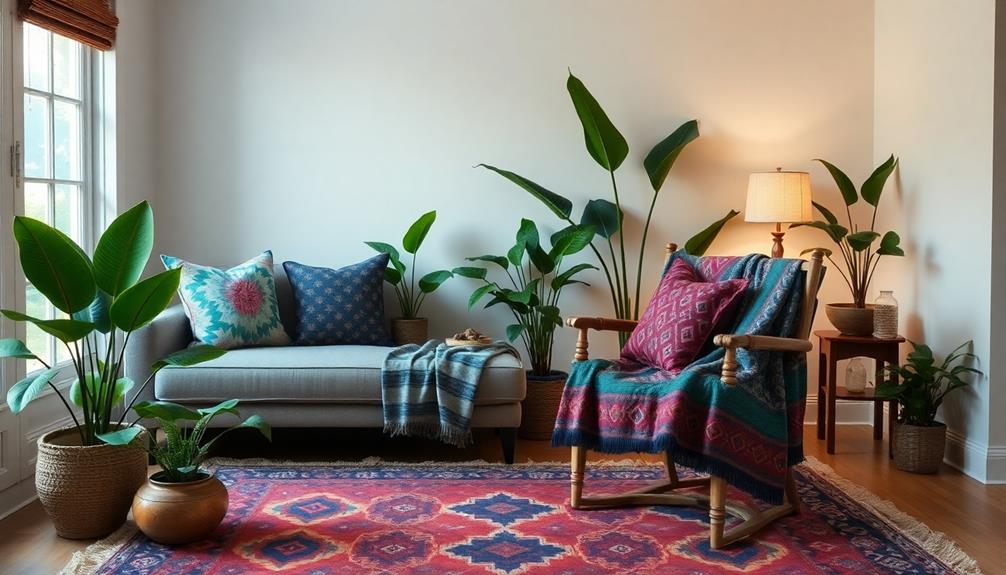
Adding ikat textiles to your decor instantly breathes life into your space with vibrant colors and intricate patterns that reflect a rich cultural heritage.
These unique fabrics not only enhance the aesthetic appeal of your home, but they also allow you to express your personal style. By choosing customizable ikat options, you support local artisans and help preserve traditional craftsmanship.
Incorporating ikat textiles—like throw pillows or wall hangings—creates a visually rich atmosphere, layering textures that draw the eye and spark interest. Each pattern often carries cultural narratives, fostering emotional connections that enrich your living space.
As you combine ikat with other textiles, you'll notice the dynamic interplay of colors and designs, creating a cozy and inviting ambiance.
Moreover, using natural fibers in ikat textiles makes for a sustainable choice in interior design. You can feel good about enhancing your decor while being eco-friendly.
Creating Conversation Starters

Transforming your space with ikat textiles not only showcases your style but also opens up opportunities for engaging conversations. Start by incorporating vibrant batik textiles as wall hangings or framed art. Their intricate patterns and UNESCO recognition make them striking conversation pieces that reflect Indonesian cultural heritage.
Next, add ikat pillows or cushions to your seating areas. Their unique designs and colors invite guests to explore the craftsmanship and stories behind each textile, creating an inviting atmosphere.
Pair these textiles with traditional artifacts like wayang puppets or hand-carved wooden masks. This combination enriches visual narratives and sparks discussions about their cultural significance and origins.
Consider creating a gallery wall that features a mix of batik and ikat designs. The interplay of colors and patterns will stimulate curiosity and conversation about the art of textile weaving.
When hosting gatherings, use batik table runners or coasters to protect surfaces while prompting conversations about the skill involved in crafting these traditional textiles. By intentionally curating these elements, you'll create a space that not only captivates but also encourages meaningful exchanges.
Emotional Connections to Textiles

Woven into the fabric of Indonesian culture, textiles like ikat and batik evoke strong emotional connections that resonate deeply with individuals. Each piece carries cultural narratives and personal stories, serving as a bridge to heritage and cherished memories. The vibrant colors and intricate patterns of ikat textiles remind you of significant life events, enriching your space with sentiment.
By incorporating textiles like Gerinsing, which symbolizes protection and is used in important ceremonies, you create an environment that reflects your unique expression and cultural significance. Purchasing these textiles enhances interior aesthetics while supporting local artisans, fostering a connection to the craftsmanship behind each creation.
Here's a quick overview of how Indonesian textiles can transform your space:
| Aspect | Emotional Connection | Cultural Significance |
|---|---|---|
| Textile Type | Ikat, Batik, Gerinsing | Each tells a personal story |
| Color & Pattern | Evokes memories | Reflects rich cultural heritage |
| Supporting Artisans | Fosters community ties | Honors traditional craftsmanship |
With Indonesian textiles, you don't just decorate; you weave your identity into your space.
Modern Applications of Traditional Art

Incorporating traditional Indonesian textiles into modern design offers a unique way to celebrate cultural heritage while enhancing your living space. By using vibrant colors and intricate patterns from textiles like ikat and batik, you can elevate the aesthetic appeal of your home.
For example, batik tablecloths and runners in your dining area not only create a cohesive look but also set the stage for gatherings that honor Indonesian culture.
You can also add ikat pillows and cushions to your living room, providing comfort while showcasing traditional craftsmanship. These elements serve as striking design features that reflect artistry and heritage.
Another modern application is creating batik wall art—frame fabric pieces or curate a gallery wall that personalizes your space and pays homage to Indonesia's rich textile traditions.
Don't forget to integrate Indonesian textiles into your home accessories. From lampshades to storage bins, these items can add texture and visual interest, transforming everyday objects into beautiful decorative pieces.
Frequently Asked Questions
Where Can I Purchase Authentic Indonesian Textiles Online?
You can purchase authentic Indonesian textiles online from platforms like Etsy, Amazon, or specialized stores like Bali Fabric. Always check reviews and seller ratings to guarantee you're getting genuine products that reflect Indonesia's rich cultural heritage.
How Do I Care for My Indonesian Textile Pieces?
To care for your Indonesian textile pieces, hand wash them gently in cold water with mild detergent. Avoid direct sunlight for drying, and store them flat or rolled to prevent creasing and damage to their vibrant colors.
Can Indonesian Textiles Be Used Outdoors?
Imagine a vibrant garden where colors dance in the breeze. You can definitely use Indonesian textiles outdoors, but remember to protect them from harsh weather. Their beauty deserves care, just like your blossoming flowers.
What Are the Common Sizes of Indonesian Textile Pieces?
Indonesian textile pieces commonly come in various sizes, like small cushions or larger wall hangings. You'll find table runners, throws, and even large tapestries, each adding unique flair to your home decor.
Are There Indonesian Textiles Suitable for Children's Rooms?
Yes, you'll find Indonesian textiles perfect for children's rooms. Look for vibrant colors and playful patterns in wall hangings, bedding, or cushions. They add a fun touch while inspiring creativity and imagination in your child's space.
Conclusion
By incorporating Indonesian textiles, you're not just enhancing your space; you're celebrating a rich cultural heritage. Did you know that Indonesia is home to over 300 distinct ethnic groups, each with their own unique patterns and weaving techniques? Embracing these textiles can create a vibrant atmosphere and spark meaningful conversations. So, whether you drape an ikat throw or hang a handcrafted wall piece, you're adding depth and storytelling to your home that's truly one-of-a-kind. These textiles aren’t just decorative elements; they are pieces of art that hold centuries of history and craftsmanship. An **Indonesian textile room transformation** can breathe new life into any interior, layering it with stories of tradition and artistry. By making these textiles a focal point, you’ll curate a space that reflects both global appreciation and personal creativity.


